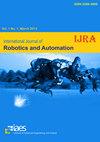离子聚合物-金属纳米复合材料(IPMCs)制备的人工柔性机器象鼻
IF 1
4区 计算机科学
Q4 AUTOMATION & CONTROL SYSTEMS
International Journal of Robotics & Automation
Pub Date : 2019-07-29
DOI:10.15406/iratj.2019.05.00186
引用次数: 2
摘要
ipmc或离子聚合物-金属复合材料是电活性聚合物(eap),具有驱动、能量收集和传感能力等特性。因此,它们是可用于仿生软机器人的多功能智能材料。它们通常需要几V/mm的小电场,并且在小电场下产生惊人的弯曲和弯曲,并且由于与环境的动态相互作用而产生瞬态电压和电流输出。环境动力学,如风或海浪,使它们产生输出电压和几mv的瞬态电流小样本(10mm x 40mm x 0.2mm)。ipmc能够在水中或水下或其他极性液体(如血液)中工作。由于外加电场的作用,共轭阳离子向阴极电泳迁移,从而使离子膜的阴极侧膨胀,从而向阳极电极弯曲。渗透压也有助于阳离子向阴极电极的迁移。Shahinpoor, Bar-Cohen, Xue, Simpson, and Smith1-2在1998年发表了IPMCs的早期版本和综述。1 - 2参见Osada, Oguro, Kawami, Asaka, Takenaka和Shahinpoor, 3-14在1992 - 1993年期间的开创性工作。阳离子在ipmc中产生和运输的电动力学是由泊松-能-普朗克场方程控制的15 - 24仿生软机器人驱动如人工肌肉和这些材料的传感显示人工肌肉行为。例如,对于尺寸为10mm x 80mm x 0.2mm的典型样品,施加1到4伏的电压通常会产生壮观的弯曲(图1)。本文章由计算机程序翻译,如有差异,请以英文原文为准。
Artificial soft robotic elephant trunk made with ionic polymer-metal nanocomposites (IPMCs)
IPMCs or Ionic polymer–metal composites are electro active polymers (EAPs) and are capable of actuation, energy harvesting, and sensing capabilities among other properties. Thus, they are multi–functional smart materials that can be used in biomimetic soft robotics. They normally require a small electric field of a few V/mm and generate spectacular bending and flexing under small electric fields and generate transient voltage and currents output due to dynamic interaction with the environment. Environmental dynamics, like wind or ocean waves, makes them generate an output voltage and transient current of a few mVs for small samples (10mm x 40mm x 0.2mm). IPMCs are capable of operating in or under water or other polar liquids, like blood. Due to the imposed electric field, the conjugated cations electrophoretically migrate towards the cathode and thus expand the cathode side of the ionic membrane and thus bending towards the anode electrode is observed. Osmotic pressures are also instrumental in the migration of cations towards the cathode electrode. Shahinpoor, Bar–Cohen, Xue, Simpson, and Smith1–2 published an early version and review of IPMCs in 1998.1–2 See the pioneering works of Osada, Oguro, Kawami, Asaka, Takenaka and Shahinpoor,3–14 in the 1992–93periods. The electrodynamics of cations generation and transportation in IPMCs are governed by the Poisson– Nernst–Planck field equations15–24 Biomimetic soft robotic actuation like artificial muscles and sensing of these materials display artificial muscle behavior. For example, an applied voltage of 1 to 4 volts for a typical sample of the size 10mm x 80mm x 0.2mm typically produces spectacular bending (Figure 1).
求助全文
通过发布文献求助,成功后即可免费获取论文全文。
去求助
来源期刊
CiteScore
1.20
自引率
44.40%
发文量
71
审稿时长
8 months
期刊介绍:
First published in 1986, the International Journal of Robotics and Automation was one of the inaugural publications in the field of robotics. This journal covers contemporary developments in theory, design, and applications focused on all areas of robotics and automation systems, including new methods of machine learning, pattern recognition, biologically inspired evolutionary algorithms, fuzzy and neural networks in robotics and automation systems, computer vision, autonomous robots, human-robot interaction, microrobotics, medical robotics, mobile robots, biomechantronic systems, autonomous design of robotic systems, sensors, communication, and signal processing.

 求助内容:
求助内容: 应助结果提醒方式:
应助结果提醒方式:


